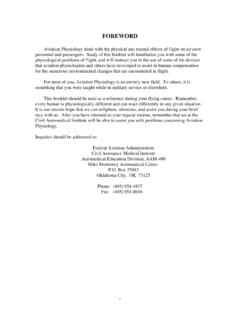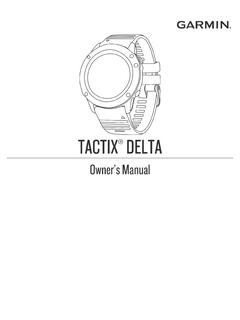Transcription of CONTAM User Guide and Program Documentation Version …
1 NIST Technical Note 1887 CONTAM user Guide and Program Documentation Version W. Stuart Dols Brian J. Polidoro This publication is available free of charge from: NIST Technical Note 1887 CONTAM user Guide and Program Documentation Version W. Stuart Dols Brian J. Polidoro Engineering Laboratory This publication is available free of charge from: September 2015 Department of Commerce Penny Pritzker, Secretary National Institute of Standards and Technology Willie May, Under Secretary of Commerce for Standards and Technology and Director iii ABSTRACT This manual describes the computer Program CONTAM Version , developed by NIST. CONTAM is a multizone indoor air quality and ventilation analysis Program designed to help determine airflows, contaminant concentrations, and personal exposure in buildings.
2 Airflows include infiltration, exfiltration, and room-to-room airflow rates and pressure differences in building systems, and can be driven by mechanical means, wind pressures acting on the exterior of the building, and buoyancy effects induced by temperature differences between zones , including the outdoors. Contaminant concentrations include the transport and fate of airborne contaminants, due to airflow, chemical and radio-chemical transformation, adsorption and desorption to building materials, filtration, and deposition to and resuspension from building surfaces. Personal exposure includes the exposure of building occupants to airborne contaminants, for eventual risk assessment. CONTAM can be useful in a variety of applications. Its ability to calculate building airflow rates and relative pressures between zones of the building is useful for assessing the adequacy of ventilation rates in a building, for determining the variation in ventilation rates over time, for determining the distribution of ventilation air within a building, for estimating the impact of envelope air-tightening efforts on infiltration rates, and for evaluating the energy impacts of building airflows.
3 The Program has also been used extensively for the design and analysis of smoke management systems. The prediction of contaminant concentrations can be used to determine the indoor air quality performance of buildings before they are constructed and occupied, to investigate the impacts of various design decisions related to ventilation system design and building material selection, to evaluate indoor air quality control technologies, and to assess the indoor air quality performance of existing buildings. Predicted contaminant concentrations can also be used to estimate personal exposure based on occupancy patterns. Version contained several new features including: non-trace contaminants, practically unlimited number of contaminants, contaminant-related libraries, separate weather and ambient contaminant files, building controls, scheduled zone temperatures, improved solver to reduce simulation times and several user interface related features to improve usability.
4 Version introduced more new features including the ability to account for spatially varying external contaminants and wind pressures at the building envelope, more new control elements, particle-specific contaminant properties, total mass released calculations and detailed Program Documentation . Version introduced two new deposition sink models, a one-dimensional convection/diffusion contaminant model for ducts and user -selectable zones , new contaminant filter models, control super nodes, super filters, a duct balancing tool, building pressurization and model validity tests and several other usability enhancements. Version added a deposition with resuspension source/sink model, a self-regulating vent airflow model, and integrated coupling between Computational Fluid Dynamics (CFD) and multizone modeling.
5 Version introduced a variable time step ordinary differential equation solver (VODE) for solving the contaminant equations and coupling between the TRNSYS energy simulation Program and CONTAM to enable combined energy, airflow and contaminant transport analysis. Version added an ultra-violet germicidal irradiation (UVGI) filter model, contaminant exfiltration result files, a SQLite database result file, and co-simulation between the EnergyPlus whole building energy analysis Program and CONTAM . Key Words: airflow analysis; building controls; building technology; co-simulation; computer Program ; contaminant dispersal; controls; energy use; indoor air quality; multizone analysis; smoke control; smoke management; ventilation iv DISCLAIMER CONTAM This software was developed at the National Institute of Standards and Technology by employees of the Federal Government in the course of their official duties.
6 Pursuant to title 17 Section 105 of the United States Code this software is not subject to copyright protection and is in the public domain. CONTAM is an experimental system. NIST assumes no responsibility whatsoever for its use by other parties, and makes no guarantees, expressed or implied, about its quality, reliability, or any other characteristic. We would appreciate acknowledgement if the software is used. This software can be redistributed and/or modified freely provided that any derivative works bear some notice that they are derived from it, and any modified versions bear some notice that they have been modified. Users are warned that CONTAM is intended for use only by persons competent in the field of airflow and contaminant dispersal in buildings and is intended only to supplement the judgement of the qualified user .
7 The computer Program described in this report is a prototype methodology for computing the airflows and contaminant migration in a building. The calculations are based upon a simplified model of the complexity of real buildings. These simplifications must be understood and considered by the user . Certain trade names and company products are mentioned in the text or identified in an illustration in order to adequately specify the equipment used. In no case does such an identification imply recommendation or endorsement by the National Institute of Standards and Technology, nor does it imply that the products are necessarily the best available for the purpose. SUNDIALS (CVODE Solver) Copyright 2002-2014, Lawrence Livermore National Security. Produced at the Lawrence Livermore National Laboratory.
8 All rights reserved. This file is part of SUNDIALS. Redistribution and use in source and binary forms, with or without modification, are permitted provided that the following conditions are met: 1. Redistributions of source code must retain the above copyright notice, this list of conditions, and the disclaimer below. 2. Redistributions in binary form must reproduce the above copyright notice, this list of conditions, and the disclaimer (as noted below) in the Documentation and/or other materials provided with the distribution. 3. Neither the name of the LLNS/LLNL nor the names of its contributors may be used to endorse or promote products derived from this software without specific prior written permission. DISCLAIMER: THIS SOFTWARE IS PROVIDED BY THE COPYRIGHT HOLDERS AND CONTRIBUTORS "AS IS" AND ANY EXPRESS OR IMPLIED WARRANTIES, INCLUDING, BUT NOT LIMITED TO, THE IMPLIED WARRANTIES OF MERCHANTABILITY AND FITNESS FOR A PARTICULAR PURPOSE ARE DISCLAIMED.
9 IN NO EVENT SHALL LAWRENCE LIVERMORE NATIONAL SECURITY, LLC, THE DEPARTMENT OF ENERGY, OR ITS CONTRIBUTORS BE v LIABLE FOR ANY DIRECT, INDIRECT, INCIDENTAL, SPECIAL, EXEMPLARY, OR CONSEQUENTIAL DAMAGES (INCLUDING, BUT NOT LIMITED TO, PROCUREMENT OF SUBSTITUTE GOODS OR SERVICES; LOSS OF USE, DATA, OR PROFITS; OR BUSINESS INTERRUPTION) HOWEVER CAUSED AND ON ANY THEORY OF LIABILITY, WHETHER IN CONTRACT, STRICT LIABILITY, OR TORT (INCLUDING NEGLIGENCE OR OTHERWISE) ARISING IN ANY WAY OUT OF THE USE OF THIS SOFTWARE, EVEN IF ADVISED OF THE POSSIBILITY OF SUCH DAMAGE. Additional BSD Notice 1. This notice is required to be provided under our contract with the Department of Energy (DOE). This work was produced at Lawrence Livermore National Laboratory under Contract No.
10 DE-AC52-07NA27344 with the DOE. 2. Neither the United States Government nor Lawrence Livermore National Security, LLC, nor any of their employees, makes any warranty, express or implied, or assumes any liability or responsibility for the accuracy, completeness, or usefulness of any information, apparatus, product, or process disclosed, or represents that its use would not infringe privately-owned rights. 3. Also, reference herein to any specific commercial products, process, or services by trade name, trademark, manufacturer or otherwise does not necessarily constitute or imply its endorsement, recommendation, or favoring by the United States Government or Lawrence Livermore National Security, LLC. The views and opinions of authors expressed herein do not necessarily state or reflect those of the United States Government or Lawrence Livermore National Security, LLC, and shall not be used for advertising or product endorsement purposes.

















